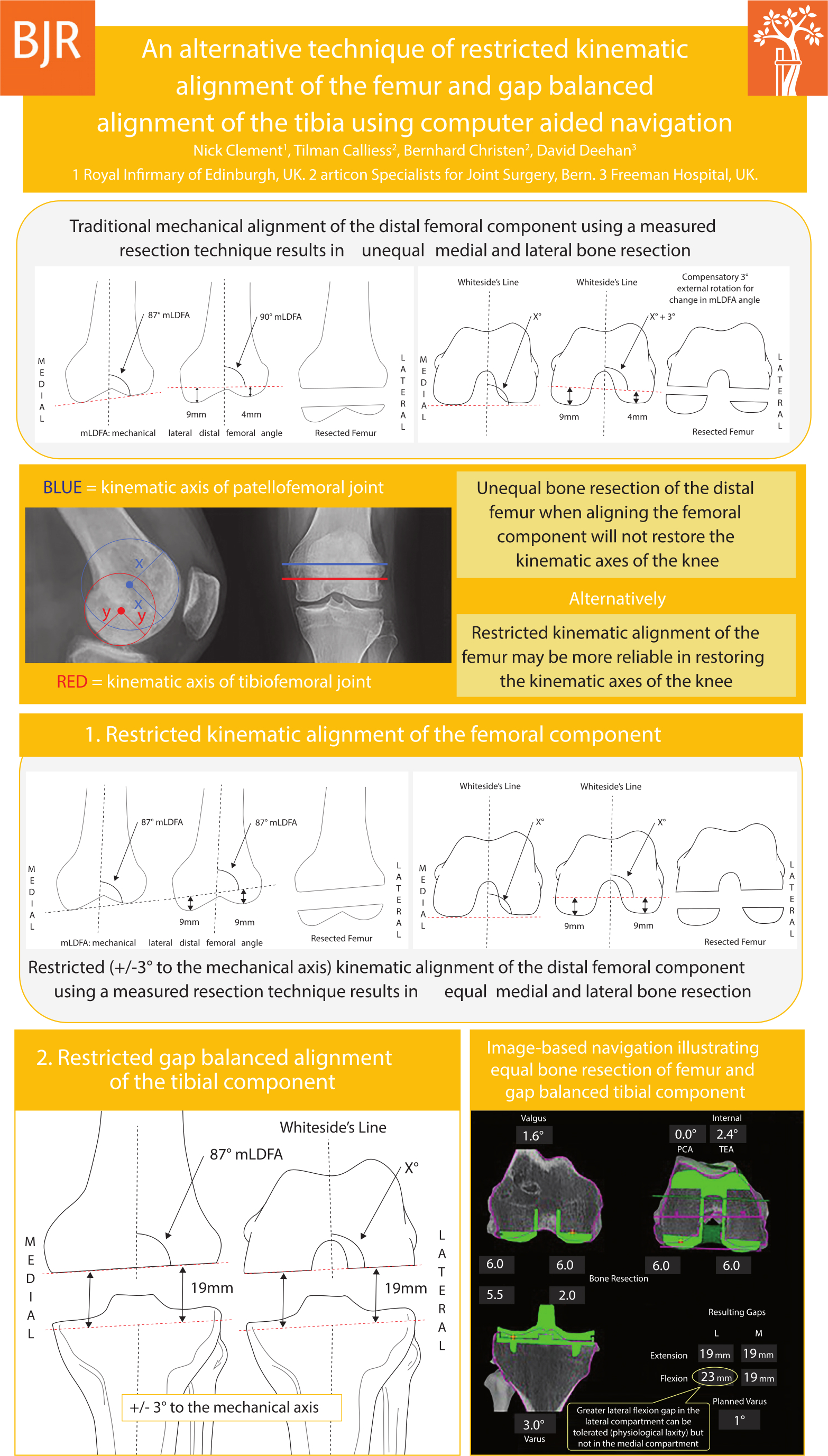The kinematic axis of the tibiofemoral joint1 and the patellofemoral joint2 passes through the distal femur. Therefore, when utilizing a single radii prosthesis it would seem optimal to align femoral component to the kinematic axes for the distal femur. Kinematic alignment would dictate that the tibial should also be aligned according to the patient’s morphology with true measured resection.3 An alternative method would be to align the tibia component using intraoperative computer-aided gap balancing; the kinematically aligned femur is used as the fixed reference to create rectangular joint spaces firstly in extension then in flexion, which can be finetuned using tibial slope. The advent of computer navigation and robotic assisted knee surgery allows the surgeon to be precise within±1° and control the final alignment.4 An additional advantage of robotic assisted surgery is that there is less damage to the soft tissue envelope,5 which may help replicate knee kinematics, reduce postoperative pain, and improve early functional outcomes.6,7
The authors describe a new technique of restricted kinematic alignment of the femoral component and using computer-aided gap balancing to align the tibial component. The femur is positioned using measured resection to maintain the centre of rotation of the knee matching the medial and lateral joint lines/contours and the trochlear groove (within±3° of the mechanical axis). Tibial resection is then dictated by the femoral prosthesis (gap balanced) aiming for equal extension and flexion gaps medially and laterally, allowing for a degree of varus or valgus to within±3° of the mechanical axis, which should not influence implant survival.8,9 The authors feel it is key to restore the isometric medial compartment balance/gap in extension and flexion, but some laxity (increased gap) can be tolerated in the lateral compartment, for which there is evidence of improved patient outcomes.10

Fig. 1
References
1. Hollister AM , Jatana S , Singh AK , Sullivan WW , Lupichuk AG . The axes of rotation of the knee . Clin Orthop Relat Res . 1993 ; 290 : 259 – 268 . PubMed Google Scholar
2. Coughlin KM , Incavo SJ , Doohen RR , et al. Kneeling kinematics after total knee arthroplasty: anterior-posterior contact position of a standard and a high-flex tibial insert design . J Arthroplasty . 2007 ; 22 ( 2 ): 160 – 165 . Crossref PubMed Google Scholar
3. Howell SM , Hull ML . Kinematic alignment in total knee arthroplasty. definition, history, principle, surgical technique, and results of an alignment option of TKA . Arthropaedia . 2014 ; 1 : 44 – 53 . Google Scholar
4. Blyth MJG , Anthony I , Rowe P , et al. Robotic arm-assisted versus conventional unicompartmental knee arthroplasty: exploratory secondary analysis of a randomised controlled trial . Bone Joint Res . 2017 ; 6 ( 11 ): 631 – 639 . Crossref PubMed Google Scholar
5. Hampp EL , Sodhi N , Scholl L , et al. Less iatrogenic soft-tissue damage utilizing robotic-assisted total knee arthroplasty when compared with a manual approach: A blinded assessment . Bone Joint Res . 2019 ; 8 ( 10 ): 495 – 501 . Crossref PubMed Google Scholar
6. Kayani B , Haddad FS . Robotic total knee arthroplasty: clinical outcomes and directions for future research . Bone Joint Res . 2019 ; 8 ( 10 ): 438 – 442 . Crossref PubMed Google Scholar
7. Clement ND , Bell A , Simpson P , et al. Robotic-assisted unicompartmental knee arthroplasty has a greater early functional outcome when compared to manual total knee arthroplasty for isolated medial compartment arthritis . Bone Joint Res . 2020 ; 9 ( 1 ): 15 – 22 . Crossref PubMed Google Scholar
8. Parratte S , Pagnano MW , Trousdale RT , Berry DJ . Effect of postoperative mechanical axis alignment on the fifteen-year survival of modern, cemented total knee replacements . J Bone Joint Surg Am . 2010 ; 92 ( 12 ): 2143 – 2149 . Crossref PubMed Google Scholar
9. Howell SM , Shelton TJ , Hull ML . Implant Survival and Function Ten Years After Kinematically Aligned Total Knee Arthroplasty . J Arthroplasty . 2018 ; 33 ( 12 ): 3678 – 3684 . Crossref PubMed Google Scholar
10. McEwen P , Balendra G , Doma K . Medial and lateral gap laxity differential in computer-assisted kinematic total knee arthroplasty . Bone Joint J 2019 ; 101-B ( 3 ): 331 – 339 . Crossref PubMed Google Scholar
Author contributions
N. D. Clement: Conceptualized and wrote the manuscript.
T. Calliess: Conceptualized and wrote the manuscript.
B. Christen: Conceptualized and wrote the manuscript.
D. J. Deehan: Conceptualized and wrote the manuscript.
Funding statement
No benefits in any form have been received or will be received from a commercial party related directly or indirectly to the subject of this article.
ICMJE COI statement
None declared.
Acknowledgements
None declared.
Ethical review statement
This study did not require ethical approval.
© 2020 Author(s) et al. This is an open-access article distributed under the terms of the Creative Commons Attribution Non-Commercial No Derivatives (CC BY-NC-ND 4.0) licence, which permits the copying and redistribution of the work only, and provided the original author and source are credited. See https://creativecommons.org/licenses/by-nc-nd/4.0/.









